

Home. India. William Wilson Hunter. Sir William Wilson Hunter KCSI CIE (15 July 1840 – 6 February 1900)[1] was a Scottish historian, statistician, a compiler and a member of the Indian Civil Service.
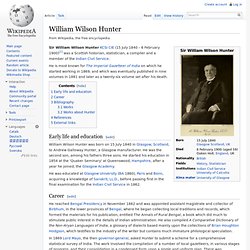
He is most known for The Imperial Gazetteer of India on which he started working in 1869, and which was eventually published in nine volumes in 1881 and later as a twenty-six volume set after his death. Early life and education[edit] William Wilson Hunter was born on 15 July 1840 in Glasgow, Scotland, to Andrew Galloway Hunter, a Glasgow manufacturer. He was the second son, among his fathers three sons. He started his education in 1854 at the 'Quaker Seminary' at Queenswood, Hampshire, after a year he joined, the Glasgow Academy. He was educated at Glasgow University (BA 1860), Paris and Bonn, acquiring a knowledge of Sanskrit, LL.D., before passing first in the final examination for the Indian Civil Service in 1862.
Career[edit] In 1872 Hunter published his history of Orissa. Hunter wrote that Hunter later said that S. Works[edit] The Valley of Kashmir - Sir Walter Roper Lawrence. Travel Distance Between Srinagar and Jalandhar. Jalandhar - Srinagar Distance - Road Map & Distance between Jalandhar and Srinagar Given below is the result for your search to find distance between Jalandhar and Srinagar.
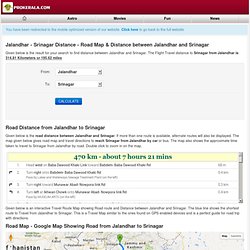
The Flight Travel distance to Srinagar from Jalandhar is 314.81 Kilometers or 195.62 miles Road Distance from Jalandhar to Srinagar Given below is the road distance between Jalandhar and Srinagar. If more than one route is available, alternate routes will also be displayed. 470 km - about 7 hours 21 mins Map data ©2014 Google Given below is an interactive Travel Route Map showing Road route and Distance between Jalandhar and Srinagar. Road Map - Google Map Showing Road from Jalandhar to Srinagar Map Data. Old city. With its almost medieval charm, the old city of Srinagar has sights, smells and sounds to enchant the most jaded traveller.

Its labyrinthine roads and bustling bazaars are a photographer's delight. Traditionally dressed men and women on their way to the city's many mosques and shrines, burnt brick buildings with their rich warm colour, these are some of the old city's moods which linger in the corners of a traveller's mind, long after one leaves Kashmir. Lending the area its vitality is the presence of the river Jhelum that flows through it. Srinagar has for long been Kashmir's most important commercial town, and when one considers that boats have always been a primary means of conveyance in Kashmir, it is not difficult to see why. Srinagar. Srinagar /sriˈnɑːɡər/ (Urdu: سری نگر; listen ) is the summer capital of the Indian State of Jammu and Kashmir.
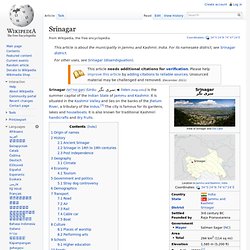
It is situated in the Kashmir Valley and lies on the banks of the Jhelum River, a tributary of the Indus.[3] The city is famous for its gardens, lakes and houseboats. It is also known for traditional Kashmiri handicrafts and dry fruits. Origin of names[edit] A River And Nine Bridges By Raja Jaikrishan. A River And Nine Bridges By Raja Jaikrishan 18 July, 2010Countercurrents.org Words like honored guests seldom oblige.

They knock at the door bolted from within. They want to get in but my hand fails to reach the bolt. Between the idea and the word there is more than we can understand. The inadvertent gaps between the words stalk. Jhelum River. Jehlam River or Jhelum River Urdu: دریاۓ جہلم, /ˈdʒeɪləm/ (Sanskrit: वितस्ता, Kashmiri: Vyeth, Hindi: झेलम, Punjabi: ਜੇਹਲਮ (Gurmukhi), (Nastaliq)) is a river that flows in India and Pakistan.

It is the largest and most western of the five rivers of Punjab, and passes through Jhelum District. It is a tributary of the Chenab River and has a total length of about 450 miles (725 kilometers).[1] Etymology[edit] The Sanskrit name of this river is Vitasta. Kashmir. Kashmir (Kashmiri: کٔشِیر / कॅशीर; Hindi: कश्मीर; Urdu: کشمیر; Uyghur: كەشمىر; Shina: کشمیر) is the northwestern region of the Indian subcontinent.
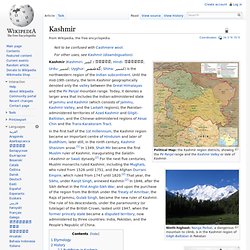
Kashmir Handicrafts, Jammu Kashmir Handicrafts, Handicraft Of Jammu Kashmir India, Jammu Kashmir India Tours, Tour Package To Jammu Kashmir. Kashmir has a great tradition of arts and handicrafts.
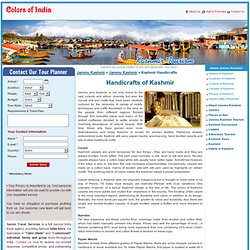
Find more.... Jammu Kashmir Culture, Culture of Jammu and Kashmir, Culture of Jammu Kashmir India, Kashmiri Culture India, Tour Package Jammu And Kashmir. Kashmir People, People of Jammu Kashmir India, Kashmiri People, Jammu Kashmir People, Jammu And Kashmir Travel Tour, Package Tours Jammu & Kashmir. According to historians, the ancestors of Kashmiris are early immigrants from India proper.
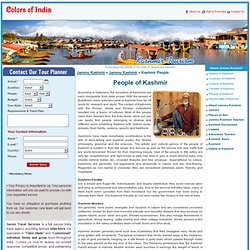
With the spread of Buddhism, many scholars came to Kashmir from far-off lands for research and study. Kashmir Cuisines, Cuisines Of Jammu And Kashmir, Kashmiri Cuisines, Kashmiri Food, Cooking in Jammu and Kashmir, Jammu and Kashmir Travel. Kashmir is known for its multi-ethnic society which has resulted in to a rich food & cuisine.
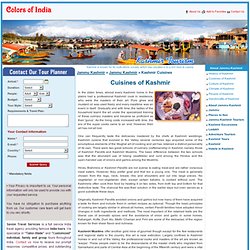
In the olden times, almost every Kashmiri home in the plains had a professional Kashmiri cook in residence, who were the masters of their art. Pure ghee and mustard oil was used freely and every mealtime was an event in itself. Samovar. Russian samovar A samovar (Russian: самовар, IPA: [səmɐˈvar] ( ); literally "self-boiler", Persian: Samāwar, Turkish: semaver) is a heated metal container traditionally used to heat and boil water in and around Russia, as well as in other Central, South-Eastern, Eastern European countries, Kashmir and in the Middle-East.
Since the heated water is typically used to make tea, many samovars have a ring-shaped attachment (Russian: конфорка) around the chimney to hold and heat a teapot filled with tea concentrate.[1] Though traditionally heated with coal or charcoal, many newer samovars use electricity to heat water in a manner similar to an electric water boiler.
Antique samovars are often displayed for their beautiful workmanship. Description[edit] Bakarkhani. Bakarkhani, also known as baqerkhani or bakar khani roti, is a thick, spiced flat-bread. Bakarkhani is almost biscuit-like in texture, with a hard crust. File:Traditional Dresses of Kashmir.jpg. Indentification Guidelines for Shahtoosh & Pashmina (U.S. Fish & Wildlife Service) Dogra. The Dogras (Dogri: डोगरा / ڈوگرا) are an Indo-Aryan ethno-linguistic group in South Asia. Being a diversified group, the Dogras include both savarnas such as Brahmins, Rajputs, Vaishyas and non-savarnas. Dogra Rajputs are believed to be Suryavanshi along with Chandravanshi Rajputs of Chattari origin. They ruled Kashmir for hundreds of years till independence.
Mughal tribe. The Mughal (Arabic: مغول; Urdu: مغل; Persian: مغول), are a number of culturally related clans of India, Pakistan and Bangladesh. [citation needed] In theory, the Mughals of South Asia are descended from the various Central Asian Turkic armies and immigrants that settled in the region from the early Middle Ages onwards. History and origin[edit] In North India, the term Mughal refers to one of the four social groups that are referred to as the Ashraaf.[1] In Pakistan, a number of tribal groupings such as the Gheba and Kassar in Punjab claim Mughal ancestry.
Sir Denzil Ibbetson, the eminent British student of Punjabi tribal structures, noted a tendency among many tribes of the Pothohar and Upper Hazara regions of Northern Pakistan to claim Mughal ancestry. [citation needed] 17th and 18th century Mughal feminine names. British Raj. The British Raj (rāj, lit. "rule" in Hindi)[2] was the British rule in the Indian subcontinent between 1858 and 1947.[3] The term can also refer to the period of dominion.[3][4] The region under British control—commonly called "India" in contemporary usage—included areas directly administered by the United Kingdom[5] (contemporaneously, "British India") as well as the princely states ruled by individual rulers under the paramountcy of the British Crown.
Jalandhar. History[edit] The Great Game.